You’ll encounter an incredible variety of different Italian regions to wander through on your travels. For those with an appreciation for culture and cuisine, a rich tapestry of different landscapes unfolds, each with its own unique appeal, waiting to be further explored.
A brief taster of Italy’s regions would include places like Lazio and Rome, with its oversized historical significance, iconic ruins, and artistic legacy.
Liguria’s Cinque Terre boasts dramatic coastlines, harmonizing sea, and cliffs, while Veneto, anchored by Venice, has enraptured travelers for centuries with its canals and eye-catching architecture.
Italy’s wide-ranging regions will provide you with a symphony of art, food, diverse geography, and fascinating history that you’ll just keep wanting to explore.
Lazio
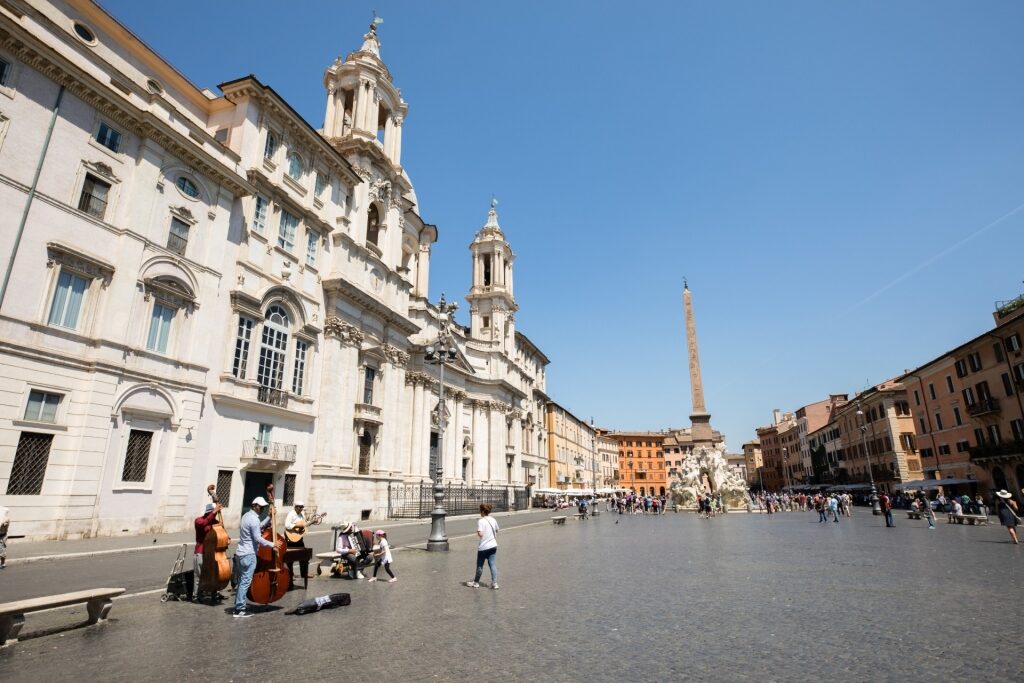
Piazza Navona in Rome, Lazio
Heading directly to the heart of Italy, Lazio, where Rome is located, encapsulates timeless appeal through its blend of history and modernity.
The region’s geographical embrace stretches from the Tyrrhenian Sea in the west to the Apennine Mountains in the east, offering an assortment of landscapes, and a maritime climate.
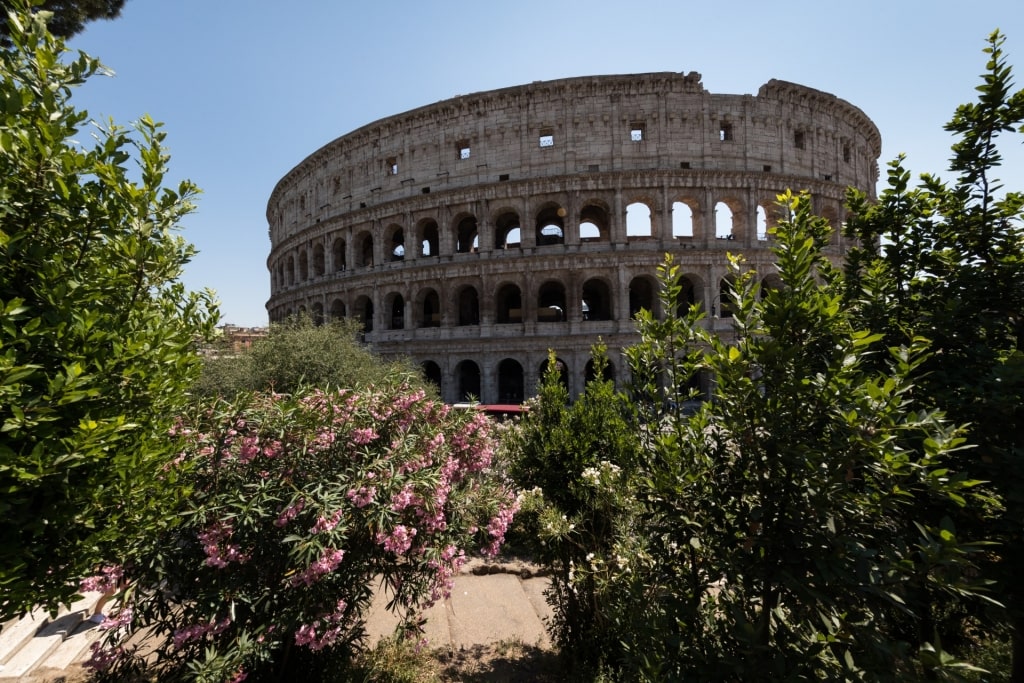
Colosseum in Rome, Lazio
In Rome, Lazio’s capital, the Colosseum has stood sentry over the city—echoing the bloody gladiatorial battles of the past—for millennia.
Piazza Navona, famed for its baroque style, will draw your attention with its grand fountains, like Fontana dei Quattro Fiumi, designed by Gian Lorenzo Bernini, and the square’s lively ambiance.
The enormous 18th-century Trevi Fountain is another well-known Roman landmark you’ll want to swing by; toss in a coin to ensure your return to the city.
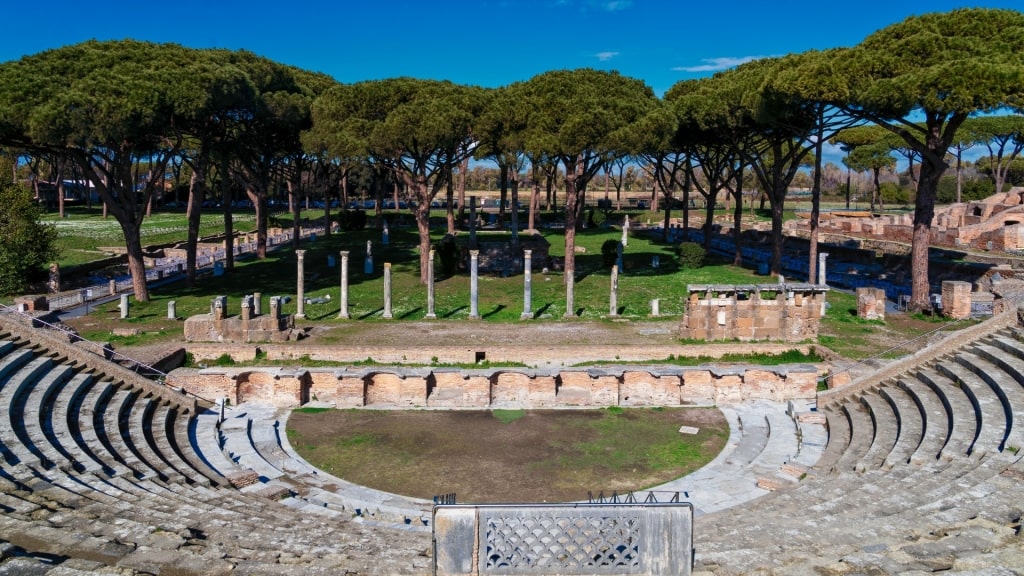
Ostia Antica, Lazio
Other destinations in Lazio worth visiting include Ostia Antica, the former ancient port town of Rome, which is now an archaeological site featuring well-preserved ruins.
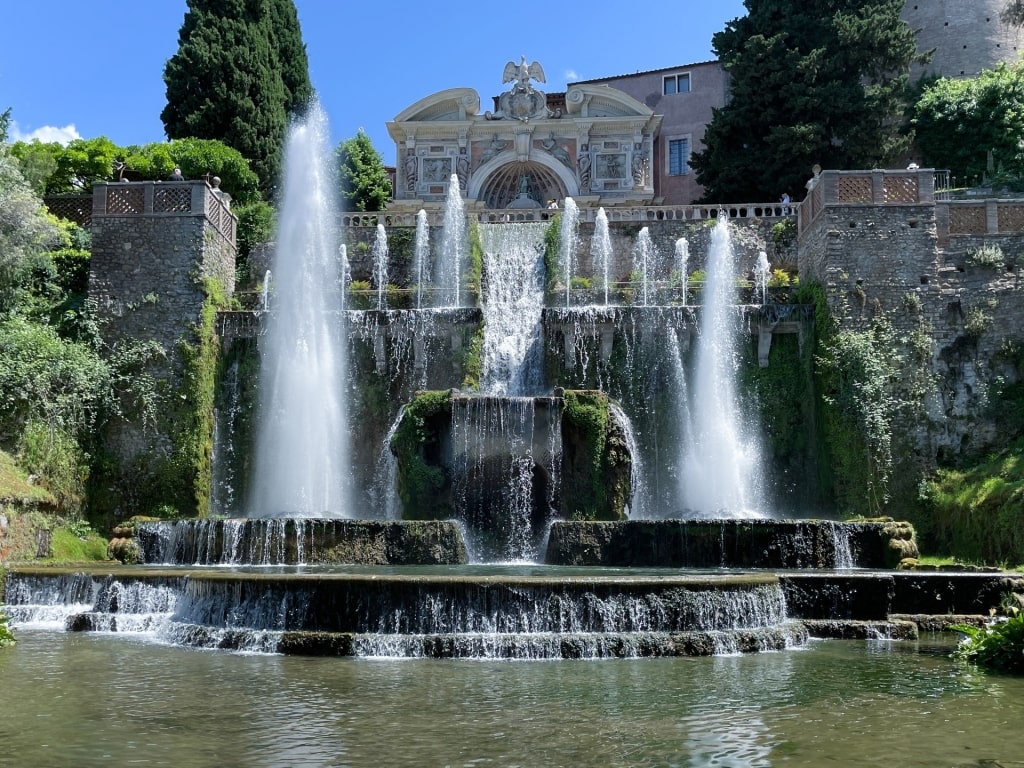
Villa d’Este in Tivoli, Lazio
Tivoli, east of Rome, wows visitors thanks to its stunning 16th-century Villa d’Este, a UNESCO World Heritage site, which features beautiful Italian gardens and fountains, and Villa Adriana (Hadrian’s Villa), an ancient Roman villa complex.
While in Lazio, you’d be remiss if you didn’t sample the local fare, with standout favorites like spaghetti carbonara (eggs, hard cheese, cured pork cheek, and black pepper). You might want to also try carciofi alla romana, which are artichokes seasoned with garlic and mint.
Read: Best Beaches Near Rome
Veneto
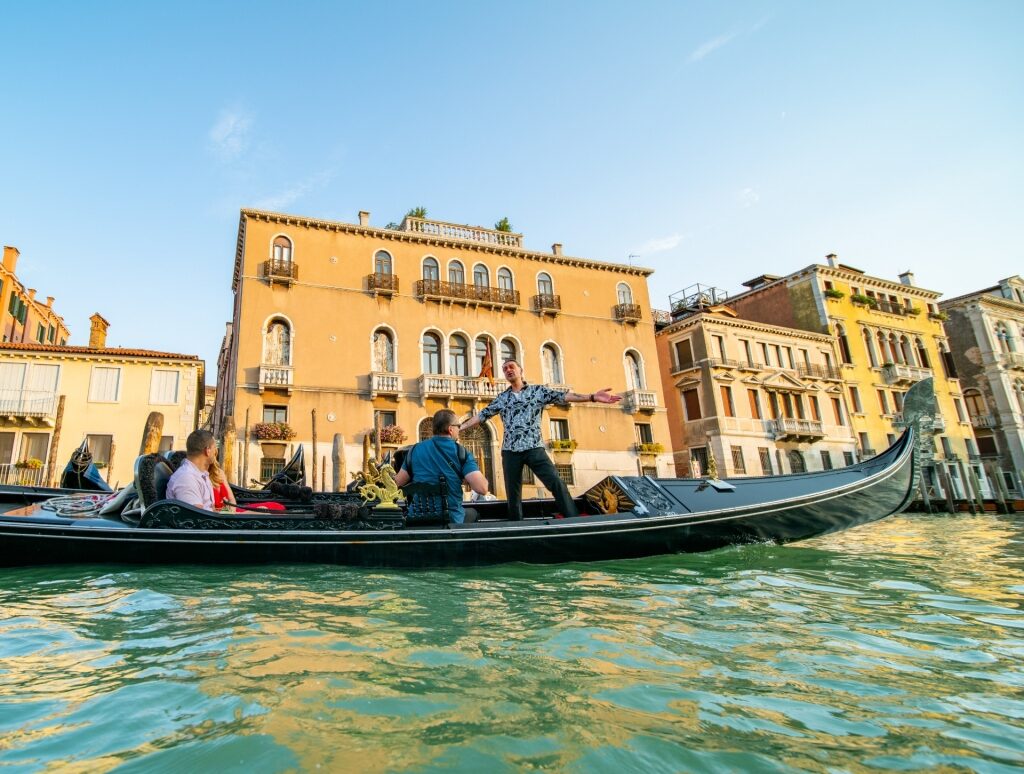
Gondola ride in Venice, Veneto
In the northeast, Veneto, bordered by the Dolomite mountains and the Adriatic Sea, numbers among the Italy regions most visited, and photographed, by travelers.
In Venice, Veneto’s biggest draw, St. Mark’s Square and Basilica loom large as ornate witnesses to this maritime city’s artistic know-how and storied past.
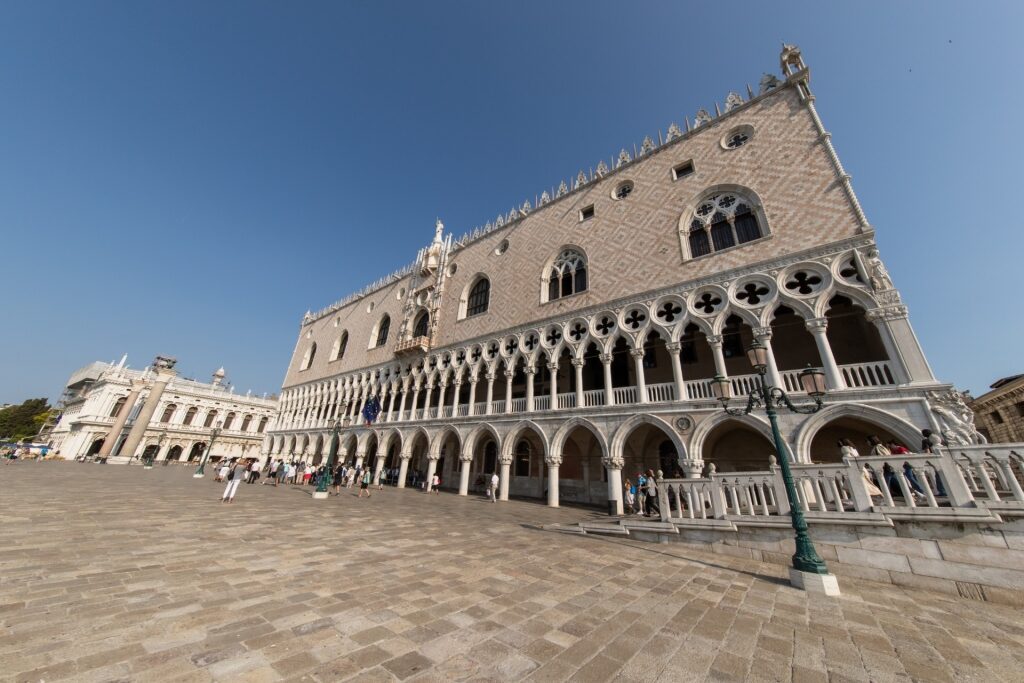
Doge’s Palace in Venice, Veneto
The Doge’s Palace, with its dazzling Venetian Gothic architecture (a blend of Byzantine, Gothic, and Renaissance elements) built across different centuries, was the site of political intrigue over the ages, while the Grand Canal is the lifeblood of the city.
Beyond Venice, you’ll find other interesting destinations to visit in Veneto. Handsome Verona is one such spot with the Adige River slicing through it. The city gained international fame as the setting for Shakespeare’s Romeo and Juliet.
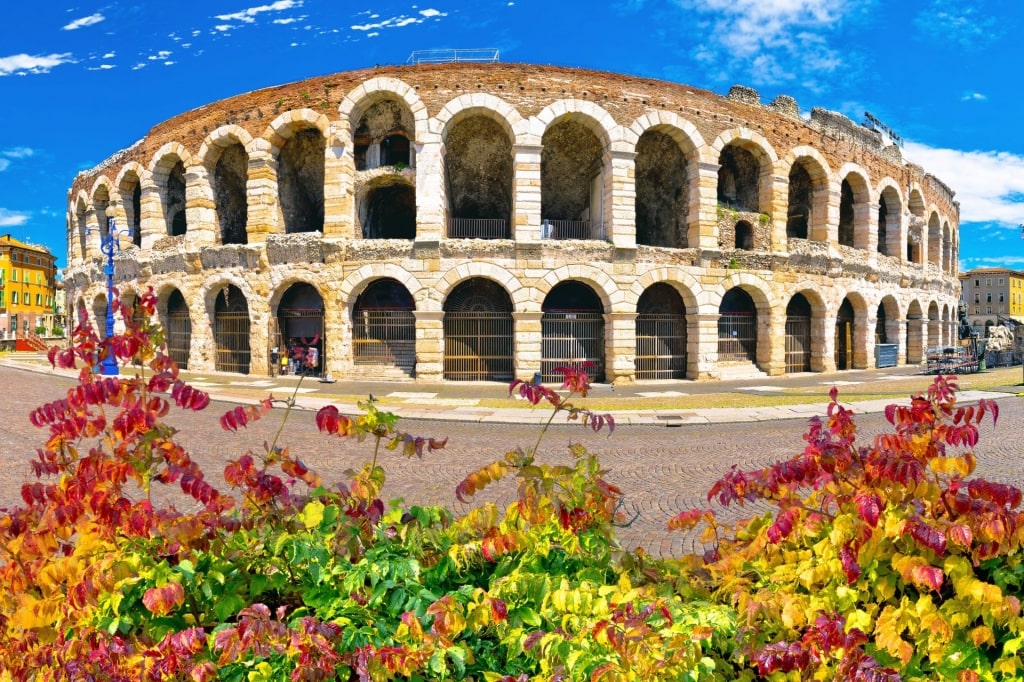
Arena di Verona, Veneto
While in town, make sure you explore the well-preserved Arena di Verona, an ancient Roman amphitheater, which still hosts concerts today.
Padova is a historical university city that is home to the Scrovegni Chapel, decorated with Giotto’s blue-tinted frescoes, and the Basilica of Saint Anthony, with its Byzantine domes.
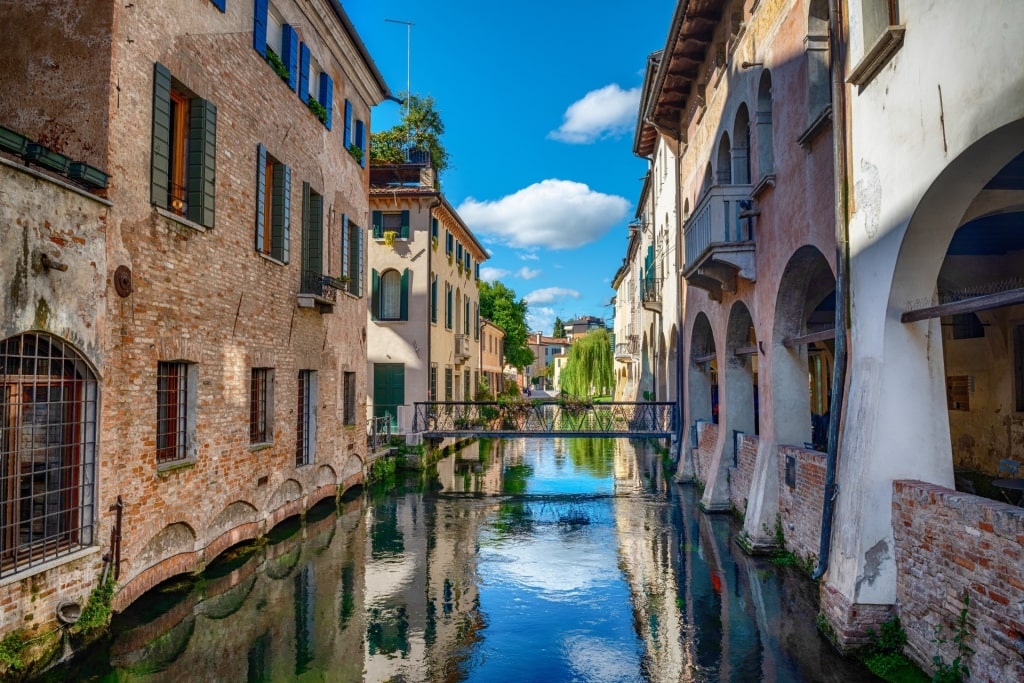
Treviso, Veneto
Treviso, or “Little Venice,” which is about a 40-minute drive north of Venice, is another regional town featuring attractive canals, medieval architecture, a pretty historic center, and plenty of spots where you can relax and enjoy some fruity, light-bodied Prosecco wines.
Emilia-Romagna
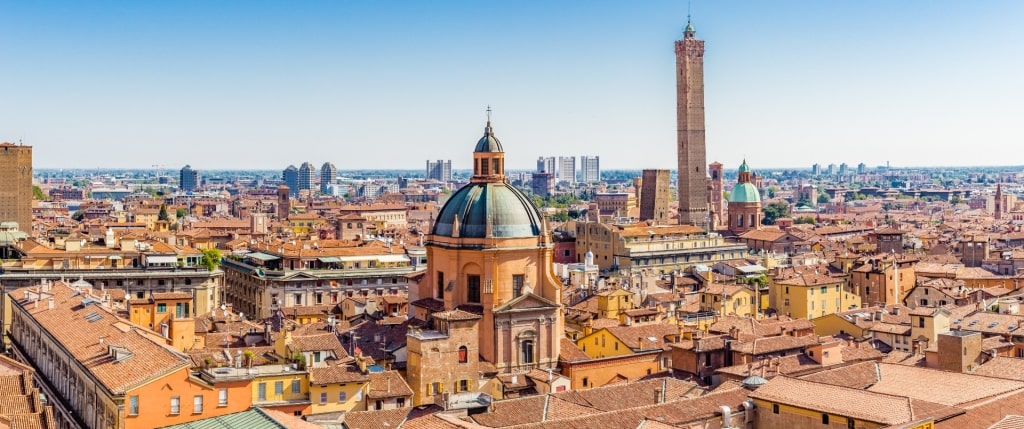
Bologna, Emilia-Romagna
Emilia-Romagna, in northern Italy (south of Venice), bubbles over with distinction. Bounded by the Apennine Mountains to the west, and the Adriatic Sea to the east, the region’s geography often reflects its diverse cultural offerings.
In Bologna, Emilia-Romagna’s centerpiece, medieval history resonates through the grand architecture. The University of Bologna, often cited as the oldest in Europe, was founded here in 1088, and boasts centuries of intellectual legacy.
It’s the city’s gastronomic prowess that often captivates visitors today, with iconic Bolognese dishes like tortellini and mortadella gracing the tables, and serving as tasty testaments to Emilia-Romagna’s epicurean talent.

Tagliatelle al ragù
Try some tagliatelle al ragù (Bolognese sauce), with flat ribbons of tagliatelle served with a slow-cooked meat-based sauce. The region is also home to the famous Parmigiano-Reggiano cheese.
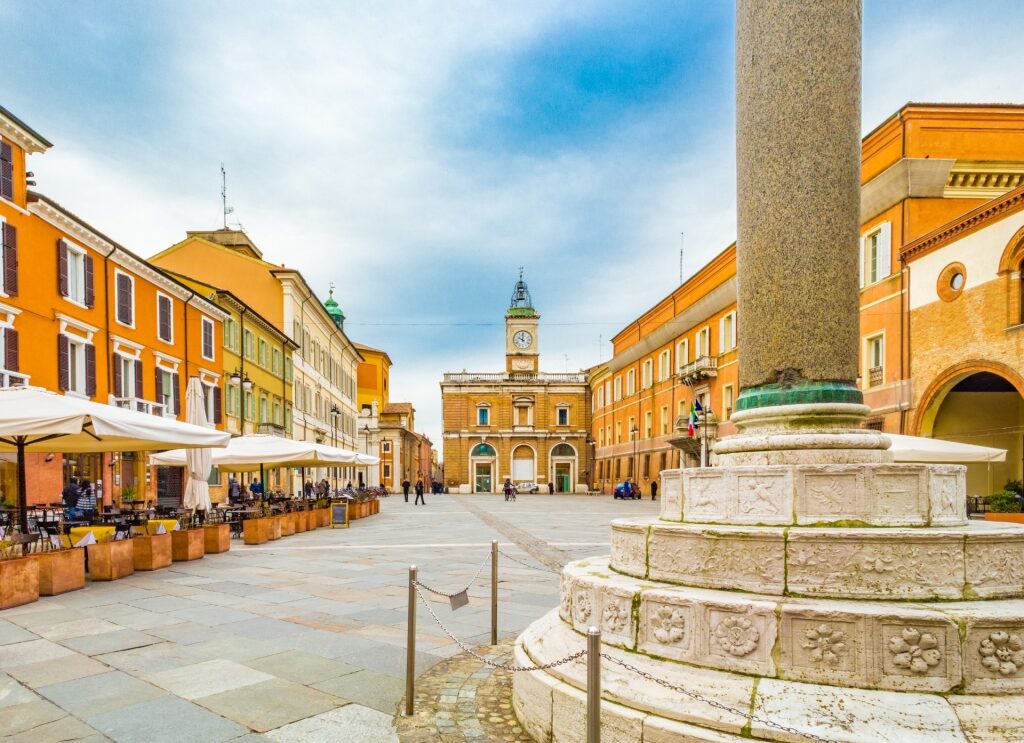
Ravenna, Emilia-Romagna
Other places of interest in Emilia-Romagna include Ravenna, one of the off-the-beaten-path gems in Italy. Ravenna is known for its superb Byzantine mosaics and lovely historic center, which is home to several exquisite basilicas and churches.
Cesenatico is a small coastal town, south of Ravenna, with an attractive canal port, which was created based on a sketch by Leonardo da Vinci. Cesenatico is also a wonderful place to enjoy some fresh seafood, a soothing seaside atmosphere, and sweeping views of the Adriatic.
Liguria
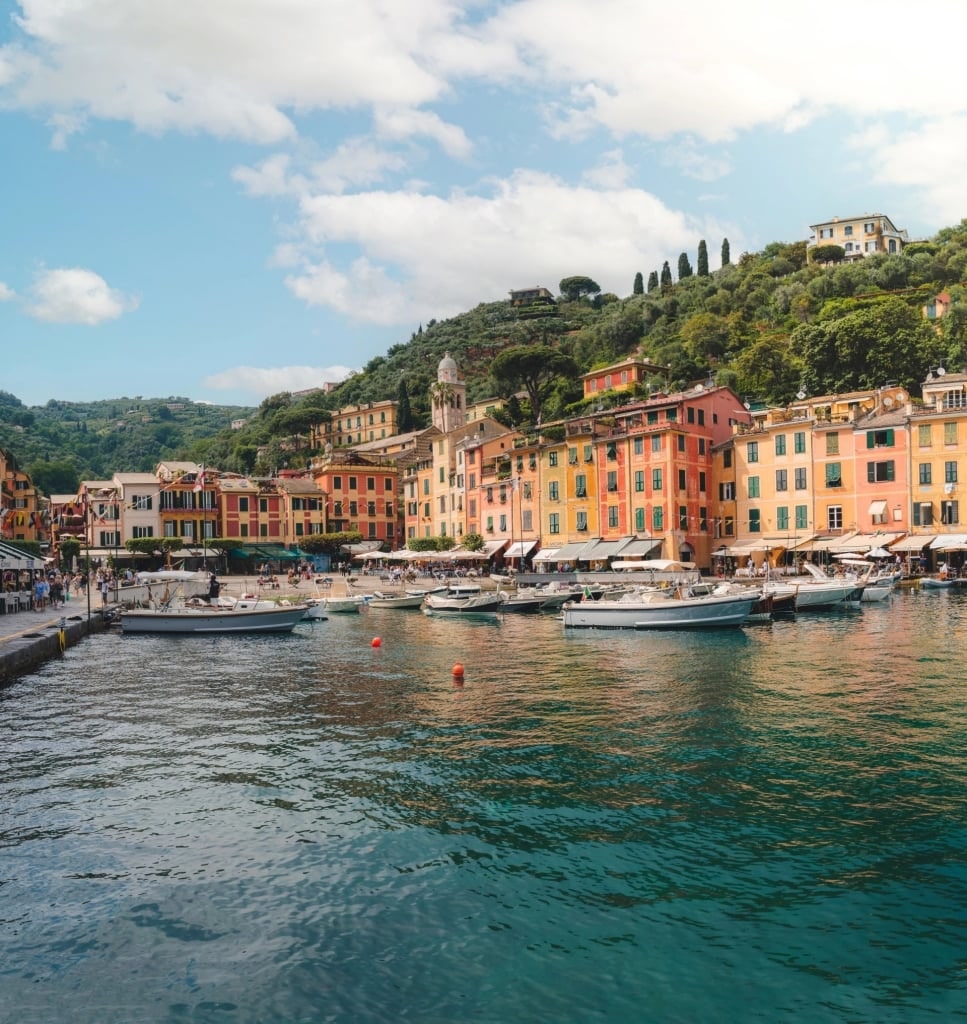
Portofino, Liguria
When it comes to Italian regions, Liguria, in northwest Italy, is about as magical as things get. The region fronts the aptly named Ligurian Sea, mixing maritime beauty with different landscapes, from azure shores to green hills.
In La Spezia, the Gulf of Poets will beckon you with its serene vibe. Portofino, a hub of coastal luxury for the world’s elite, bewitches travelers with its pastel-hued villas, sparkling harbor, and multi-hued charm.
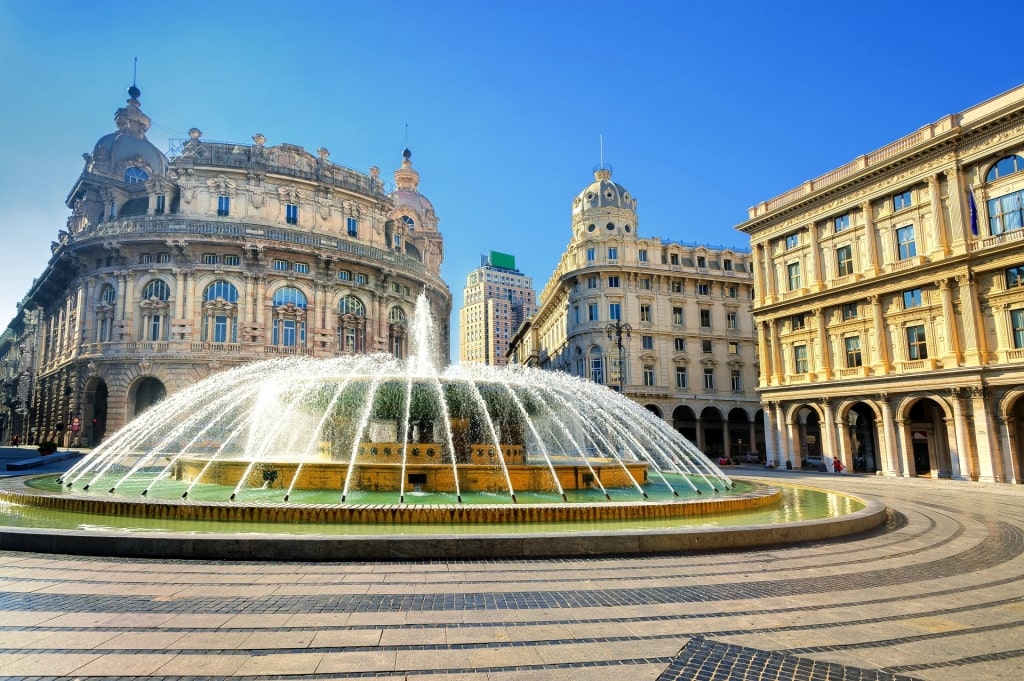
Genoa, Liguria
Genoa, Liguria’s historic capital, steeped in maritime history and medieval architecture, will invite you to explore the city’s narrow carruggi alleyways. As you wander, try to imagine what life was like here in centuries past.
The five vibrant villages of Cinque Terre are one of Liguria’s biggest draws. These towns— connected by hiking paths, train tracks, and boats—are situated atop cliffs and feature pastel facades, steep inclines, and terraced vineyards.
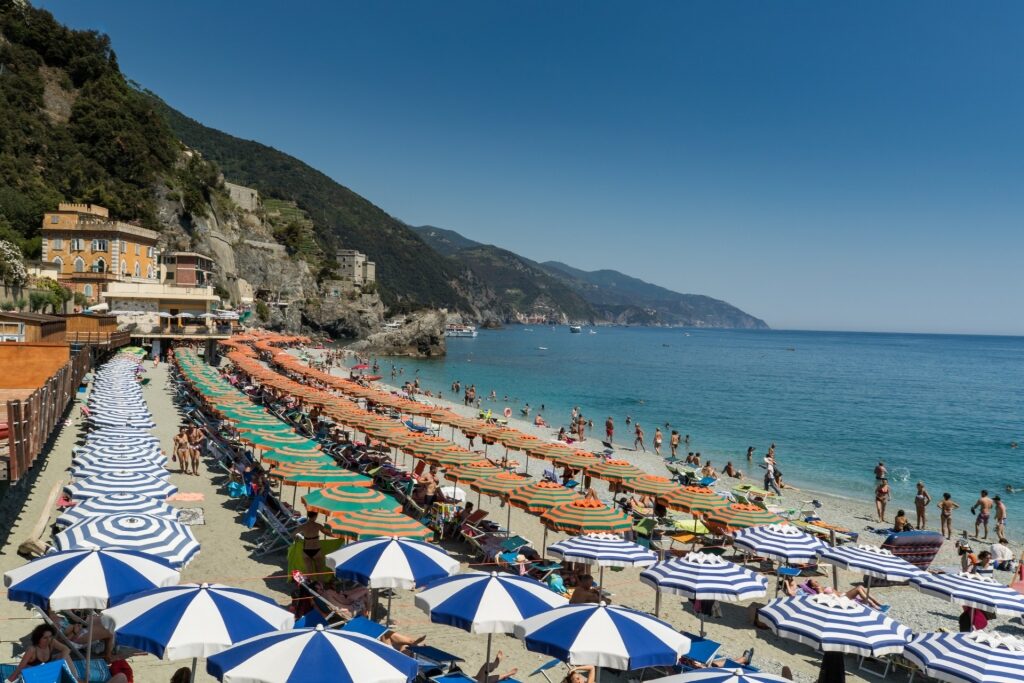
Monterosso al Mare, Liguria
Monterosso al Mare, the northernmost town in Cinque Terre, is known for its sandy beaches and Italian Riviera allure. Vernazza, south of Monterosso, benefits from a scenic harbor and brightly colored buildings.
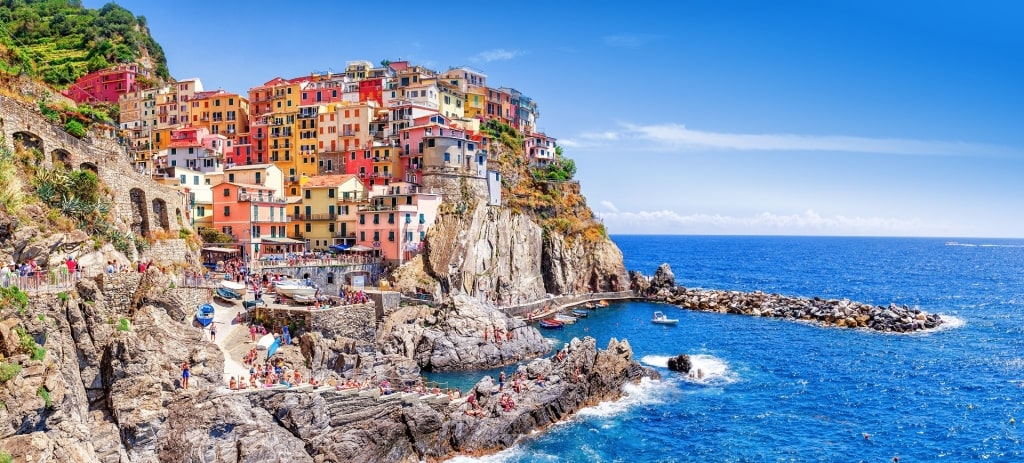
Manarola, Liguria
And you could be forgiven for a bout of vertigo after visiting Cinque Terre’s Corniglia, as it’s located atop a tall cliff. Manarola, also perched on high, comes with magnificent views of the sea. Finally, you have Riomaggiore, with its lovely little houses cascading down toward the sea.
Tuscany
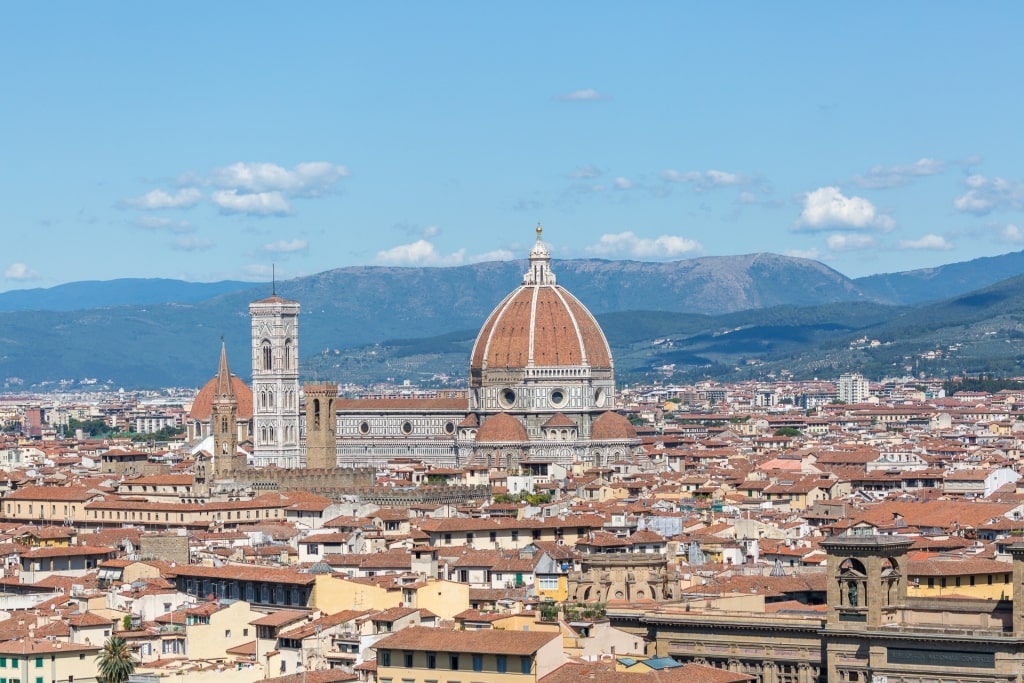
Florence, Tuscany
Tuscany, in central Italy, calls to mind rolling hills, vineyard-dotted landscapes, and a deeply rooted artistic heritage of art, architecture, food, and wine.
Bordered by the Tyrrhenian Sea in the west, the region’s topography provides visitors with a diverse backdrop as they set out to explore.
In Florence, visit the iconic Duomo Santa Maria del Fiore—also known as the Florence Cathedral—with its massive dome, designed by Filippo Brunelleschi.
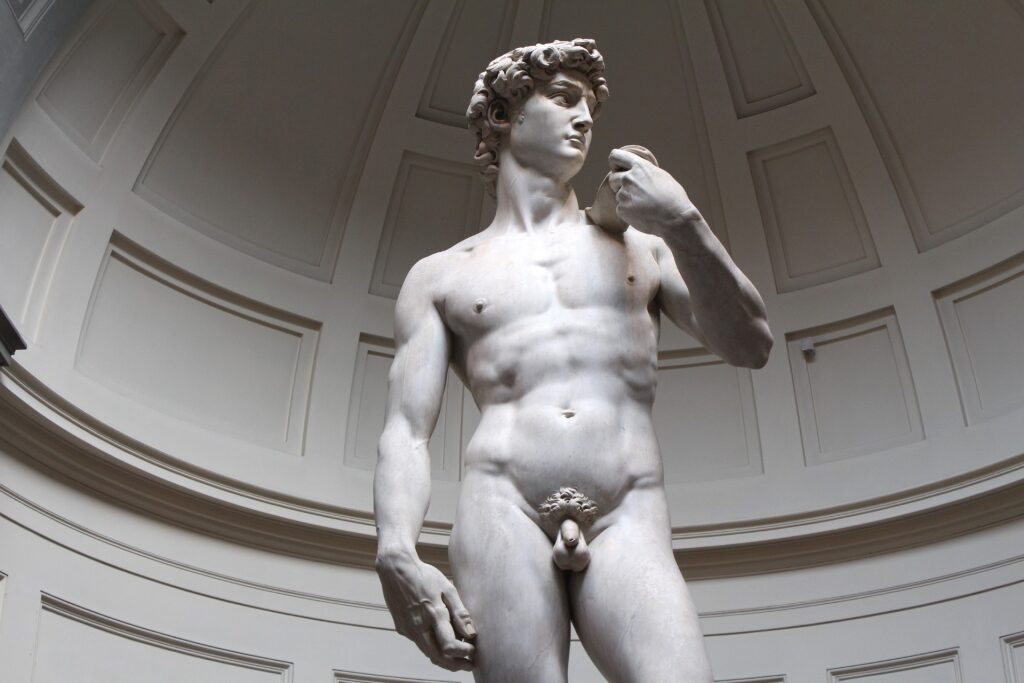
Accademia Gallery in Florence, Tuscany
Florence’s Accademia Gallery is home to Michelangelo’s sublime David and other works by the sculptor, and is an important destination for art lovers.
Closer to the sea, you have the Italian city of Pisa, with its legendary leaning tower, a marvel of medieval architecture with a characteristic tilt due to soft soil on one side.
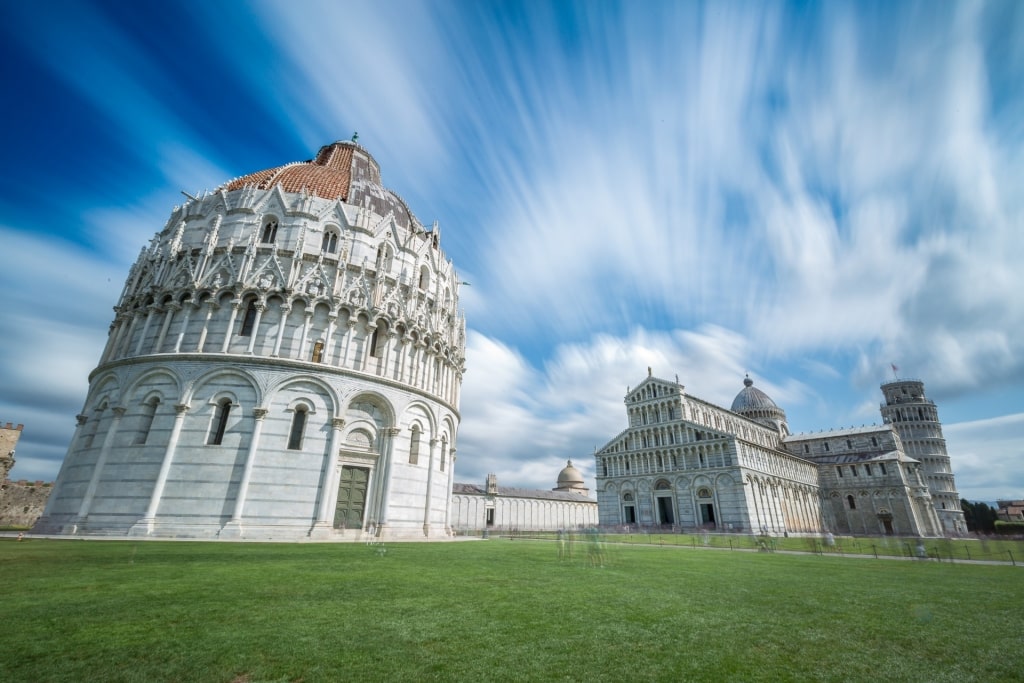
Piazza dei Miracoli in Pisa, Tuscany
Pisa also hosts the historical Piazza dei Miracoli, or “Square of Miracles,” filled with a grouping of impressive architectural structures, like the Romanesque Cathedral of Santa Maria Assunta, and the octagonally shaped Baptistery of St. John.
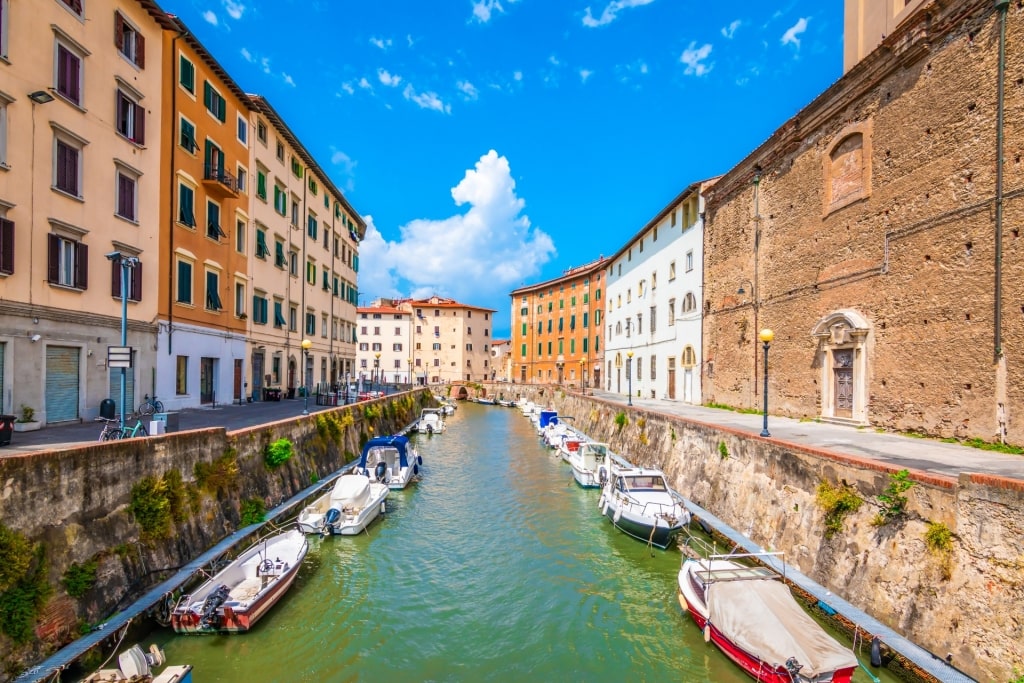
Livorno, Tuscany
Livorno, on the Tuscan coast, is a divine spot to soak in the region’s maritime traditions, along with the town’s Venetian-like network of canals, and perhaps dine on some great seafood.
Tuscany is also famed for its exceptional cuisine and wines. Pappa al pomodoro is a rustic tomato and bread soup, often seasoned with garlic, basil, and olive oil, that you’ll want to try. And it’s hard to go wrong with crispy almond-based biscotti, along with a glass of Vin Santo dessert wine.
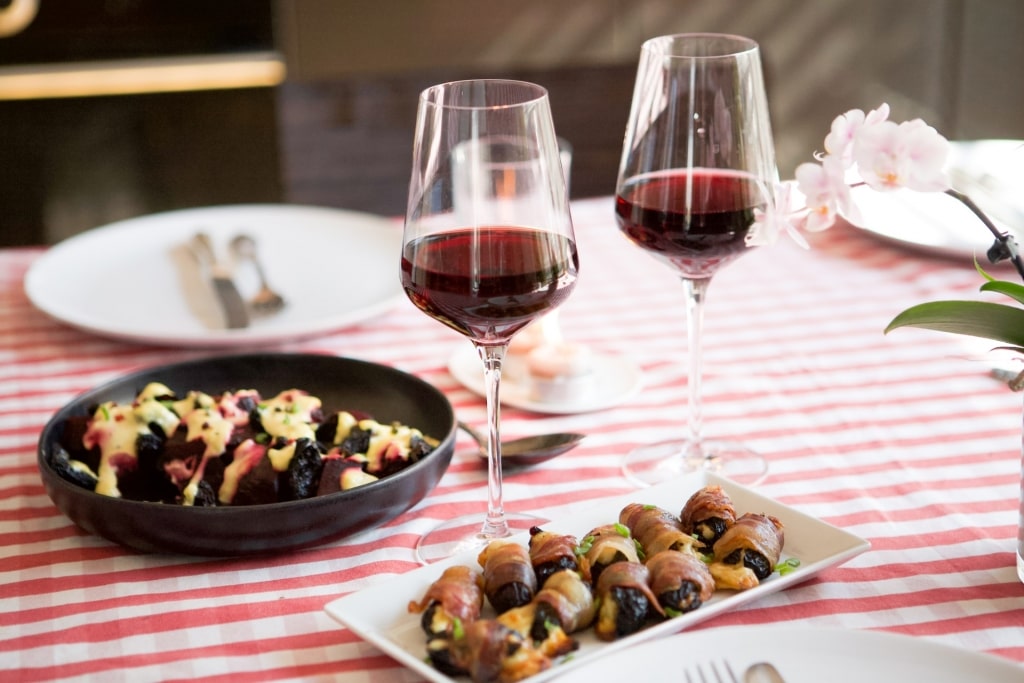
Red Chianti
For even more of the wine that Italy is known for, a red Chianti, from Tuscany’s Chianti region, should go down nicely. The same can be said for the earthy, full-bodied Brunello di Montalcino, from Sangiovese grapes, produced in the town of Montalcino, in Siena, Tuscany.
Read: Best Beaches in Tuscany
Puglia
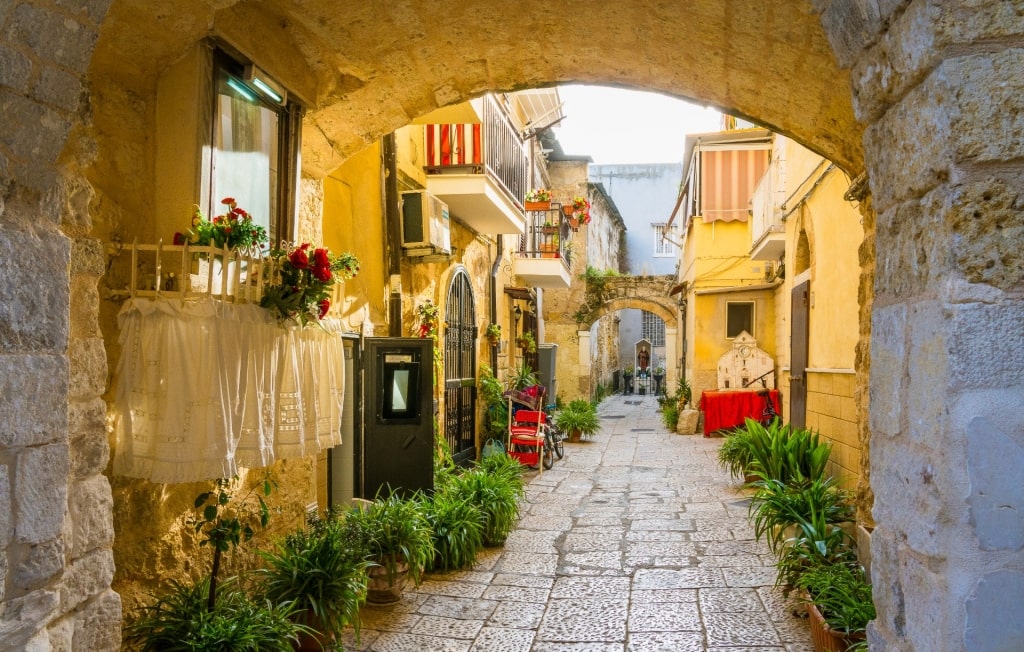
Bari, Puglia
Puglia, in the south of the Adriatic, is the sunny “heel” of Italy’s famous boot-shaped geography.
Bari is the capital of Puglia and offers a mix of history-infused ambiance and modern life. Explore the historic old town, known as Bari Vecchia, featuring slender alleyways, ancient churches, and the impressive, white Romanesque Basilica of Saint Nicholas.
Bari’s bustling waterfront promenade and local markets will give you a taste of the region’s overall Adriatic vibe and cuisine as well.
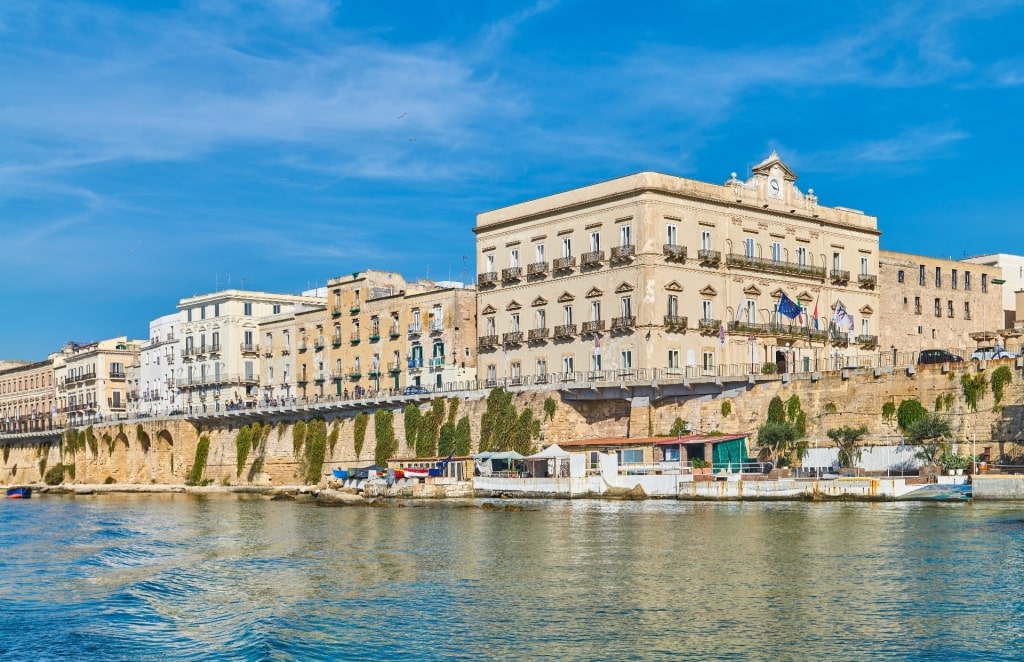
Taranto, Puglia
Another destination favored by cruise ships in Puglia is Taranto, marked by its fascinating old town, which can offer you insights into Magna Graecia, which means “Great Greece” in Latin, as this part of Southern Italy was once colonized by ancient Greek settlers.
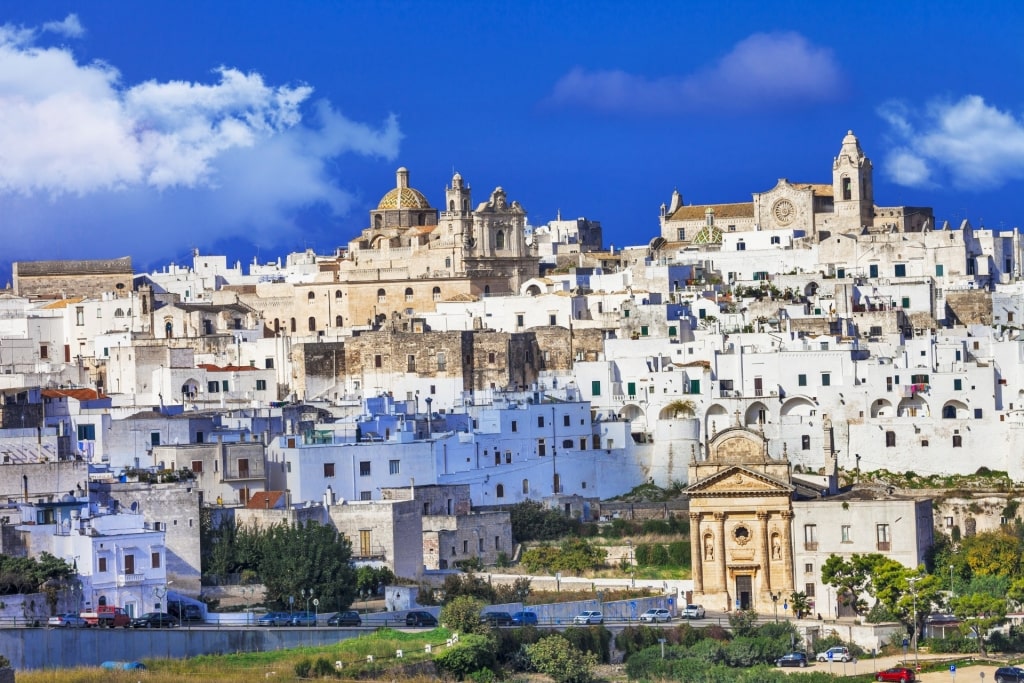
Ostuni, Puglia
Other points of interest include Ostuni, also known as La Città Bianca, or the “White City,” which dazzles with its gleaming architecture, white façades, labyrinthine streets, and expansive hilltop vistas.
Lecce, which has been coined as the “Florence of the South” due to its limestone Leccese stone and museum-like atmosphere, enthralls with its Baroque grandeur.
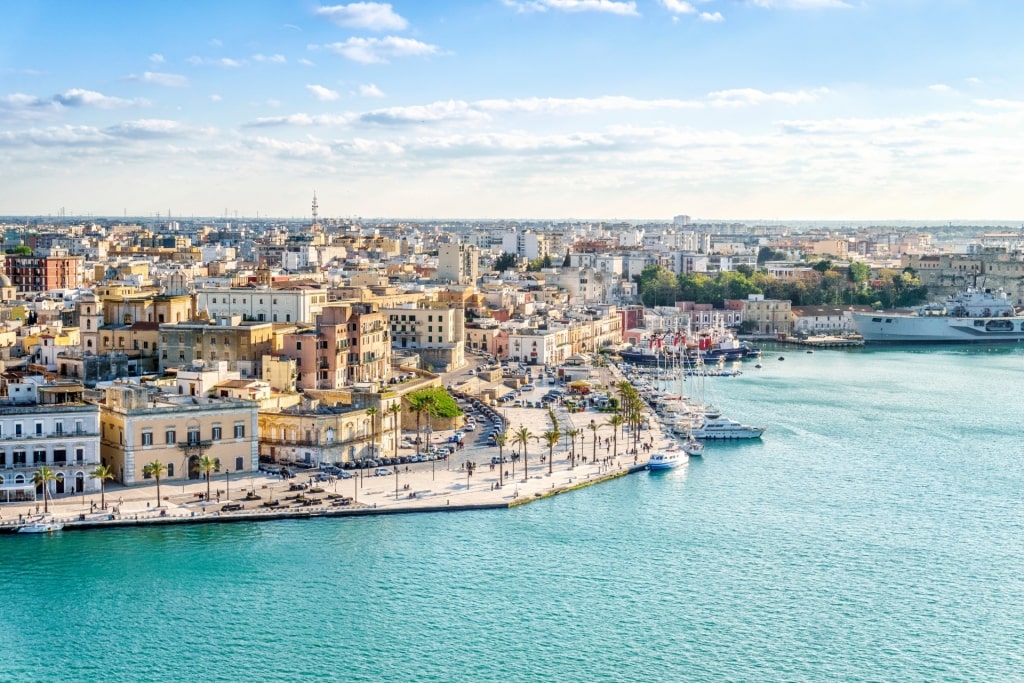
Brindisi, Puglia
Brindisi, north of Lecce, features a natural harbor that harkens back to Roman times and still sees heavy use today.
Campania
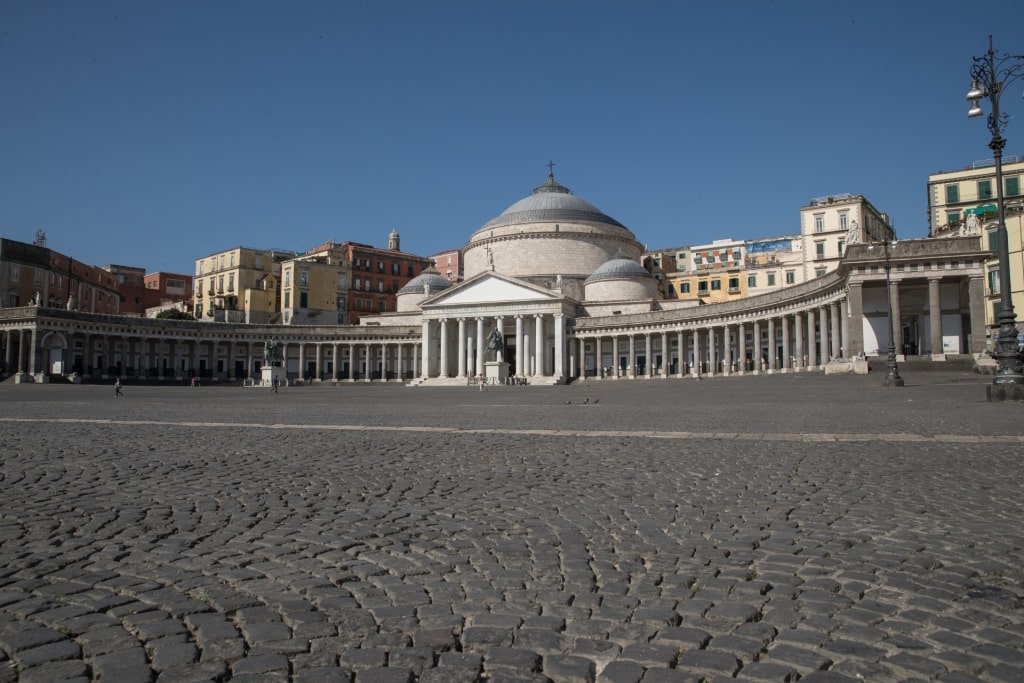
Piazza del Plebiscito in Naples, Campania
Campania is yet another one of those Southern Italy regions that were seemingly made for postcards and social media photos. The region extends from the Tyrrhenian Sea’s sapphire-colored waters to the rugged Apennine Mountains.
The urban core of Campania is undoubtedly Naples, which has captured the imagination of the world with its history, and wonderful cuisine: pizza margherita and marinara, spaghetti alle vongole with clams, and plenty more.
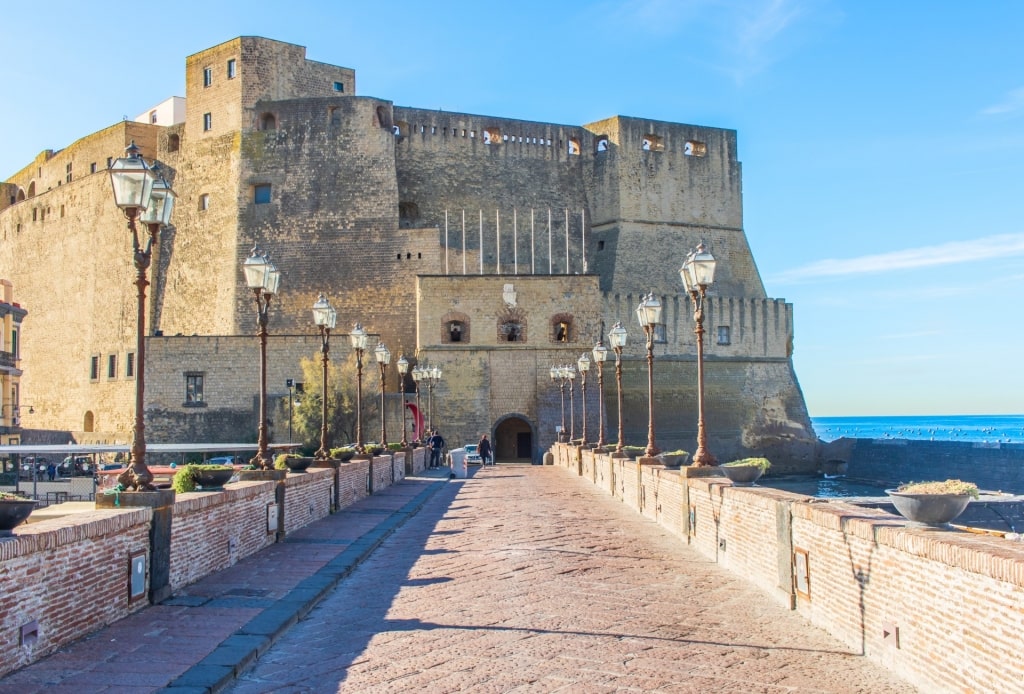
Castel dell’Ovo in Naples, Campania
One of the best things to do in Naples is to visit Piazza del Plebiscito, where you’ll find the Royal Palace of Naples (Palazzo Reale), and the neoclassical Basilica of San Francesco di Paola. Castel dell’Ovo, or Castle of the Egg, is an ancient fortification butting up against the sea that you won’t want to miss either.
Naples exudes dynamic chaos blending art, life, and food. Nearby, the ancient ruins of Pompeii, and the Roman city of Herculaneum, will offer you a fascinating glimpse into the past.
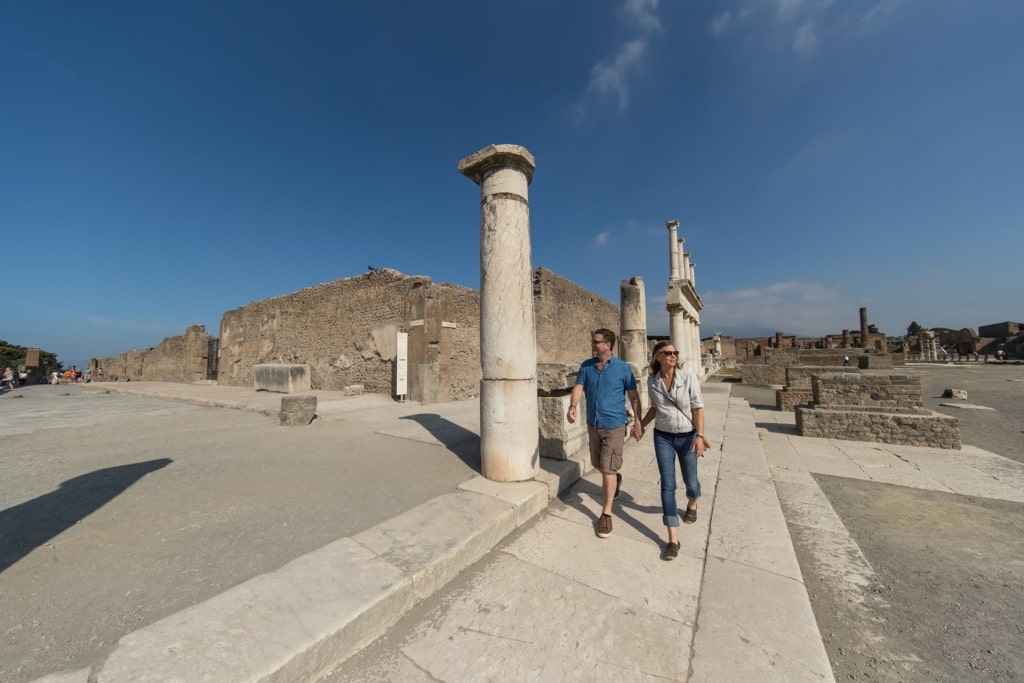
Pompeii, Campania
Ancient Pompeii was frozen in time by the eruption of Mount Vesuvius in 79 AD, which covered the urban center in deadly volcanic ash and pumice.
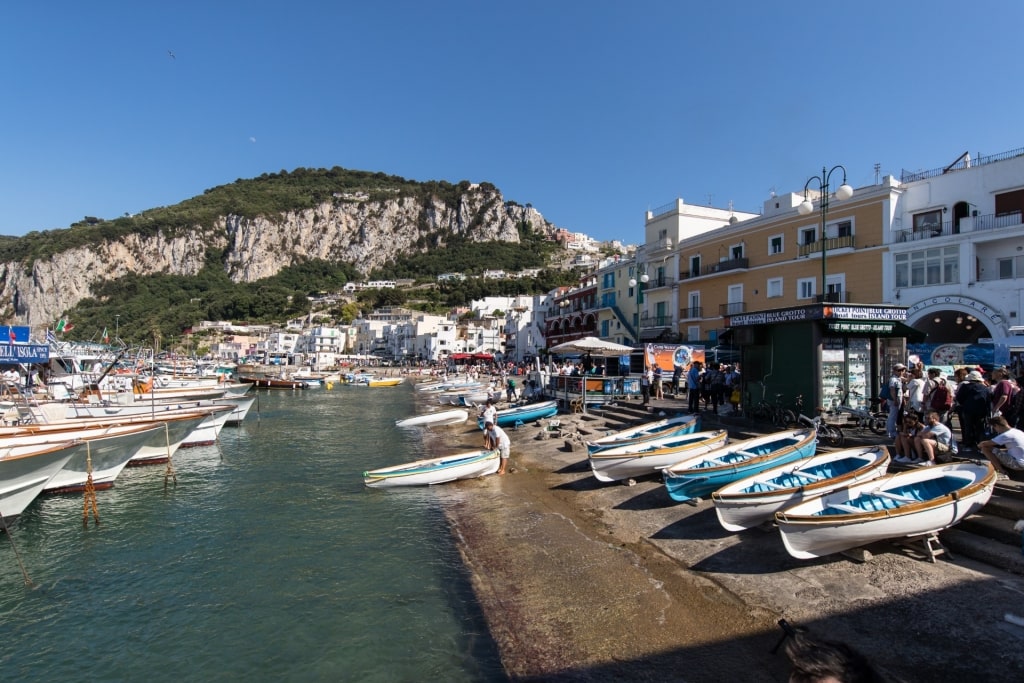
Capri, Campania
If you enjoy island life, make your way over to sophisticated Capri, near the southern tip of the Gulf of Naples.
A big attraction here is the Blue Grotto sea cave, delighting visitors with its iridescent blue waters. Capri’s designer boutiques and chic ambiance make the island a luxury shopping destination as well.
Back on the mainland, enjoy the hillside town of Sorrento, known for its quaint streets, lined with artisanal shops and cafés, and bars serving refreshing limoncello lemon liqueur.
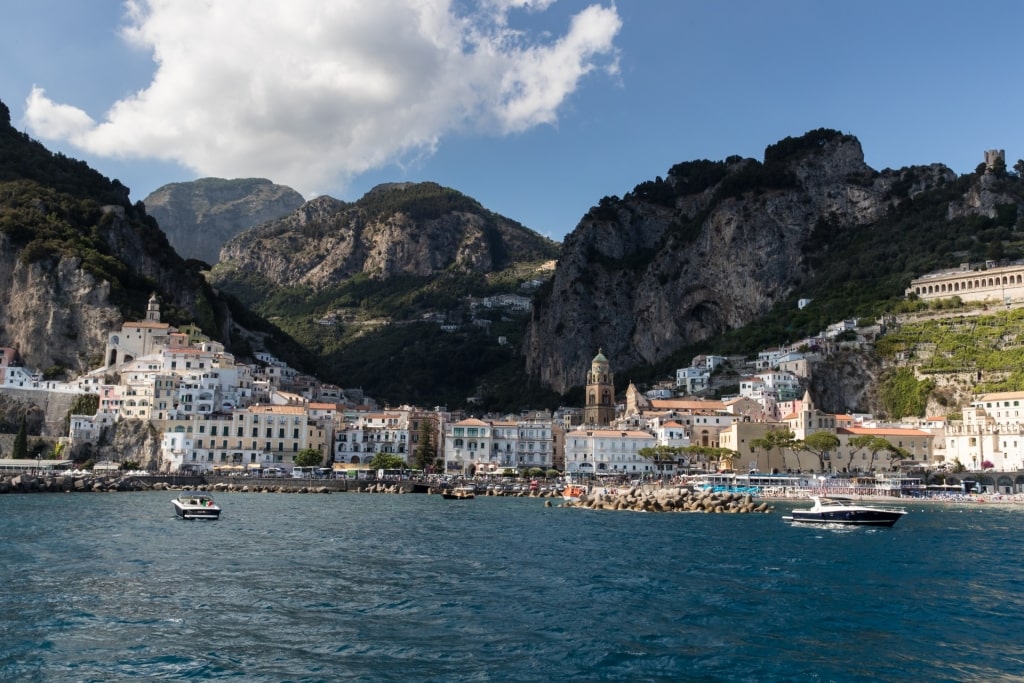
Amalfi, Campania
The Amalfi Coast’s scenic beauty, precipitous coastline, and lemon-scented villages, south of Naples, complete Campania’s irresistible allure. You’ll be glad you carved out time to take in Positano’s colorful façades, Amalfi’s medieval cathedral, and Ravello’s mind-blowing sea views.
Sicily
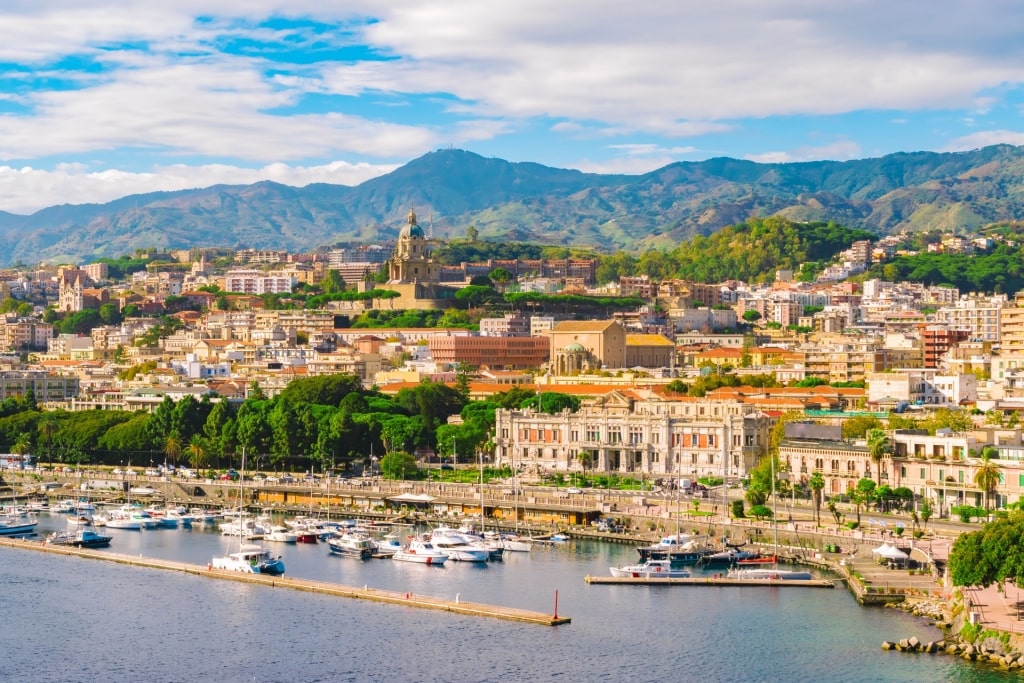
Messina, Sicily
Sicily stands out due to its mix of Greek, Roman, Arab, and Norman influences. This cultural fusion has shaped the island’s unique architecture, gastronomy, and traditions, making it a crossroads of the Mediterranean.
The island, resting between the Tyrrhenian and Ionian Seas, is further enriched by striking landscapes like Mount Etna, its mesmerizing seaboard, and an inviting Mediterranean climate.
In Messina, in the northeast, you can explore the city’s historic architecture, German-built astronomical clock, and natural harbor.
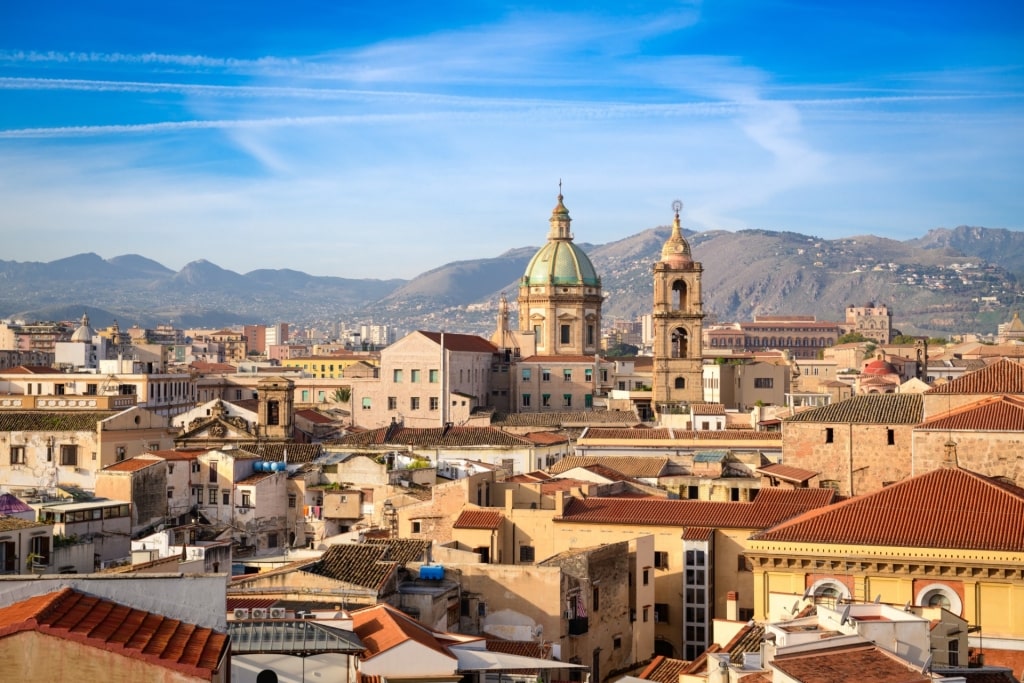
Palermo, Sicily
The Sicilian town of Palermo reflects a blend of Arab, Norman, and Byzantine influences, exemplified by the Palazzo dei Normanni (the current seat of the regional government), and the Cappella Palatina royal chapel.
Visits to Ballarò and Vucciria markets are also some of the best things to do in Palermo, offering you the chance to try street food and soak up the local ambiance.
The Teatro Massimo, demonstrating Palermo’s love for the arts, is one of the largest opera houses in Europe, and another notable structure you may want to check out.
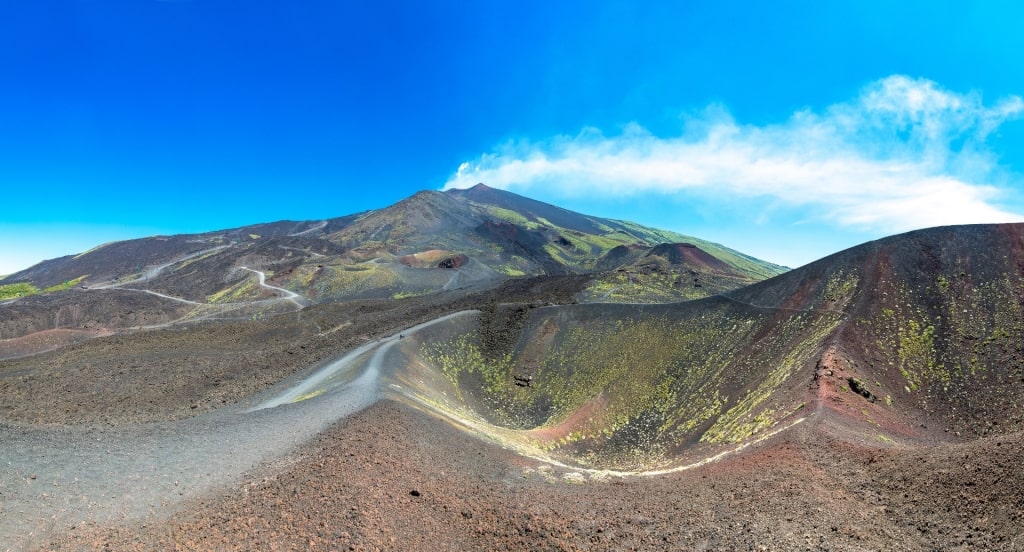
Mount Etna, Sicily
You can also venture up the slopes of Etna, Europe’s tallest active volcano, for a memorable geological encounter—provided the massive volcano isn’t acting up.
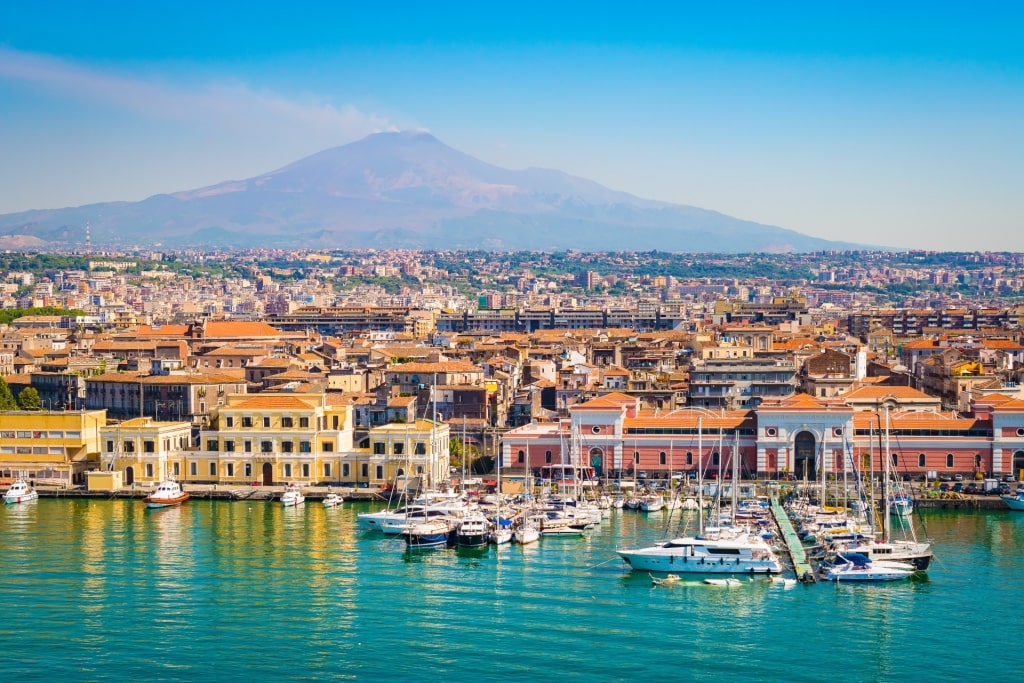
Catania, Sicily
If you’re not up for a strenuous hike, Catania, positioned on Sicily’s eastern shores, can offer you volcanic-themed pleasures too.
This municipality is known as the “gray city” thanks to its lava-stone buildings. And with nearby Mount Etna commanding the skyline, you’ll get all of the mountain views you could ever hope for.
Sardinia
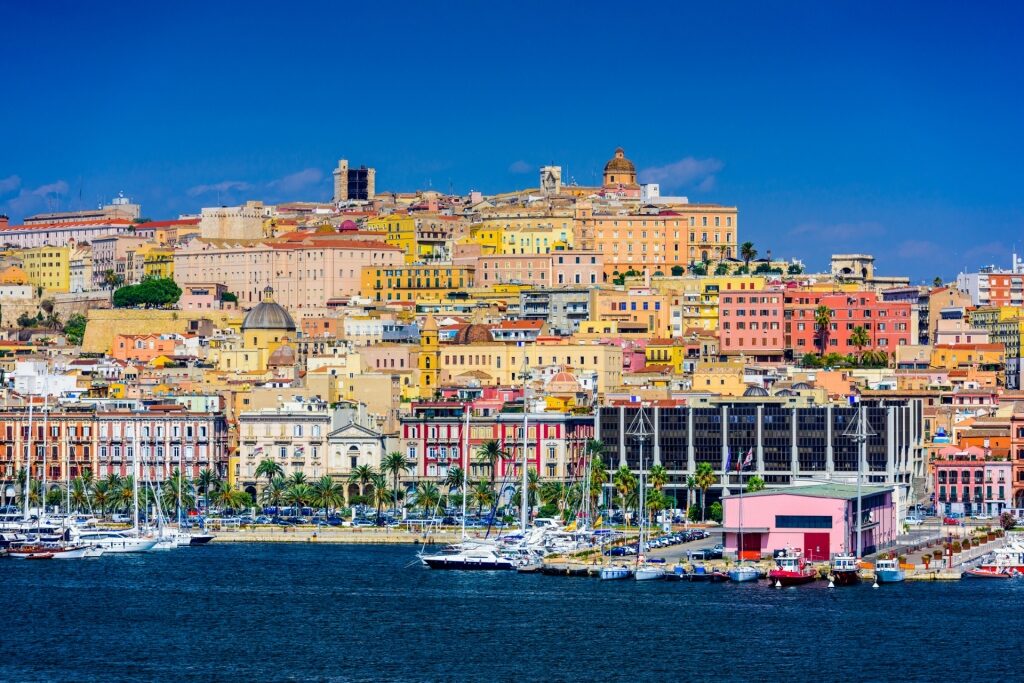
Cagliari, Sardinia
Among Italian regions, the autonomous island region of Sardinia will provide you with another collection of distinctive cultural landscapes. West of the mainland, Sardinia is surrounded on all sides by the Mediterranean.
Along the coastline, you’ll find sandy Sardinian beaches, rocky coves, and cliffs, while the interior is dominated by mountain ranges and hills. You’ll also find one of Europe’s deepest gorges on the island, the Gola Su Gorropu.
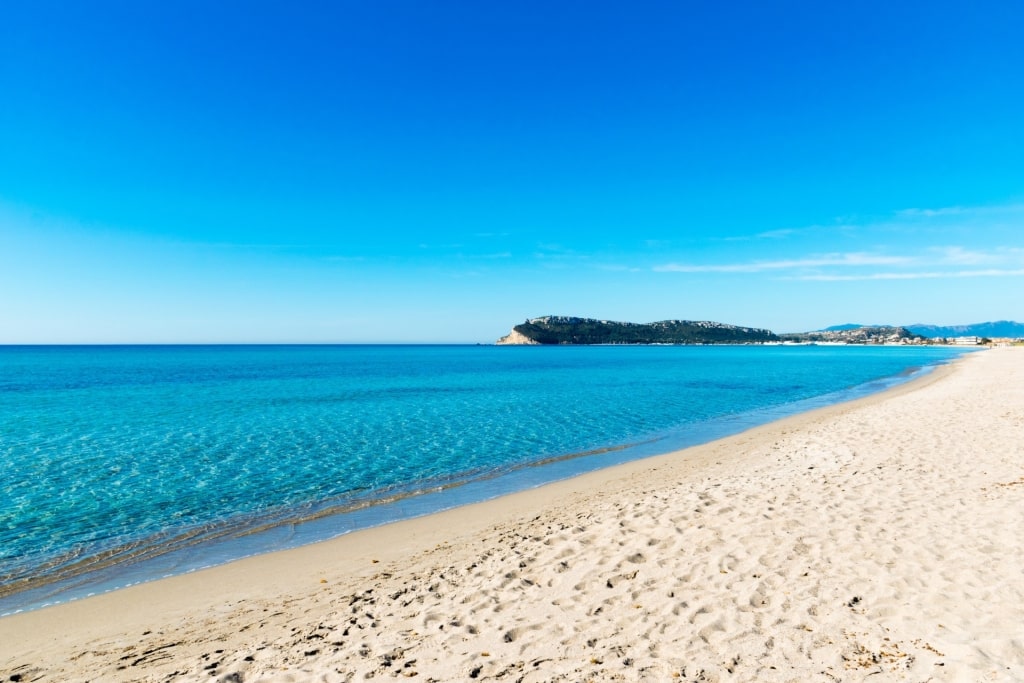
Poetto Beach in Cagliari, Sardinia
In Cagliari, the capital, the famous Poetto Beach, nearly five miles long, invites beachgoers to linger thanks to its fantastic seaside vibe.
Cagliari’s hilltop Old Town, or Castello district, also astounds with its network of narrow lanes, medieval walls, and delightful piazzas. It also houses the 13th-century Pisan-Romanesque Cagliari Cathedral.
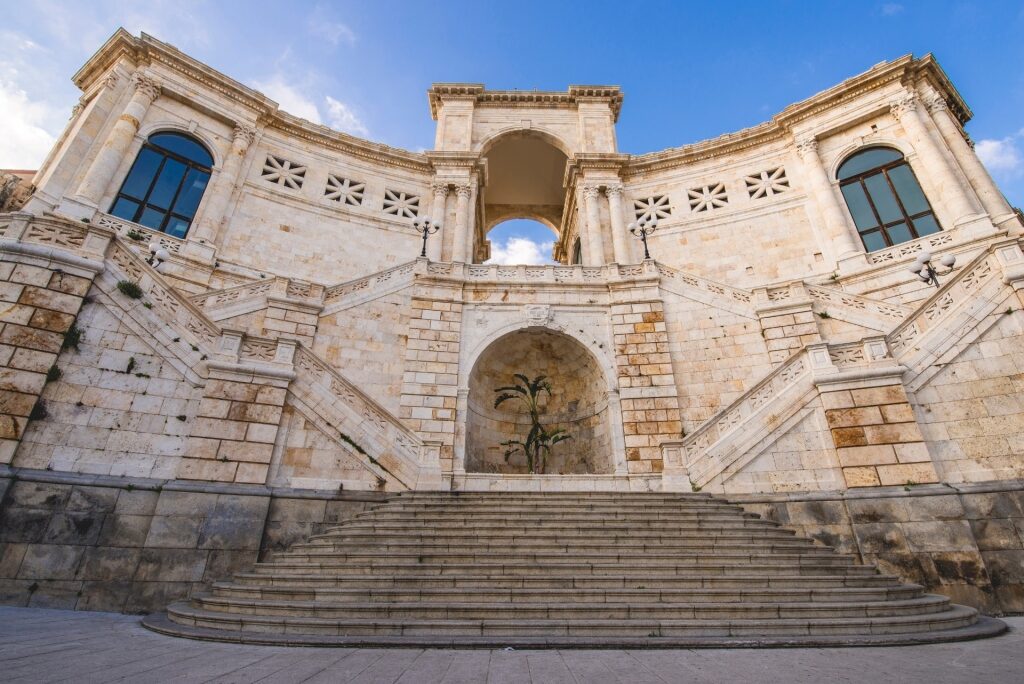
Bastione San Remy in Cagliari, Sardinia
The ornate Bastione San Remy, built on a high promontory, is where locals and visitors gather for wonderful views. San Benedetto Market is where you should go to investigate stalls overflowing with fresh seafood, local cheeses, vegetables, and other regional specialties.
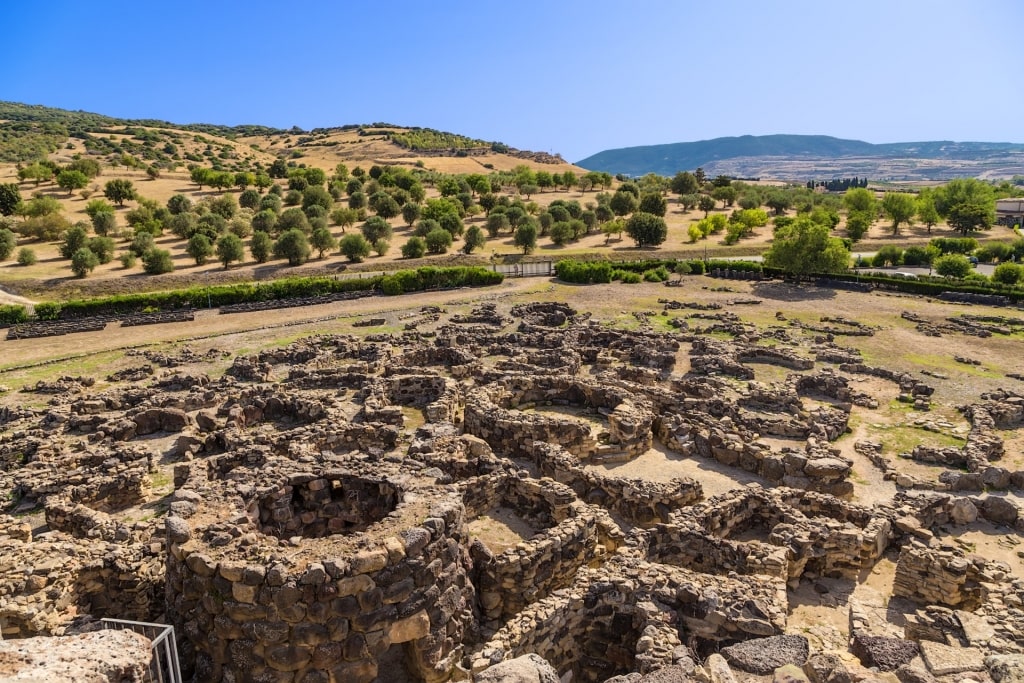
Su Nuraxi, Sardinia
The archaeological site of Su Nuraxi is a remarkable showcase for the Bronze Age Nuragic civilization, known for its mortarless stone towers.
The ancient town of Nora and the Pula Archaeological Park will offer you insights into Sardinia’s Phoenician and Roman heritage through their well-preserved ruins.
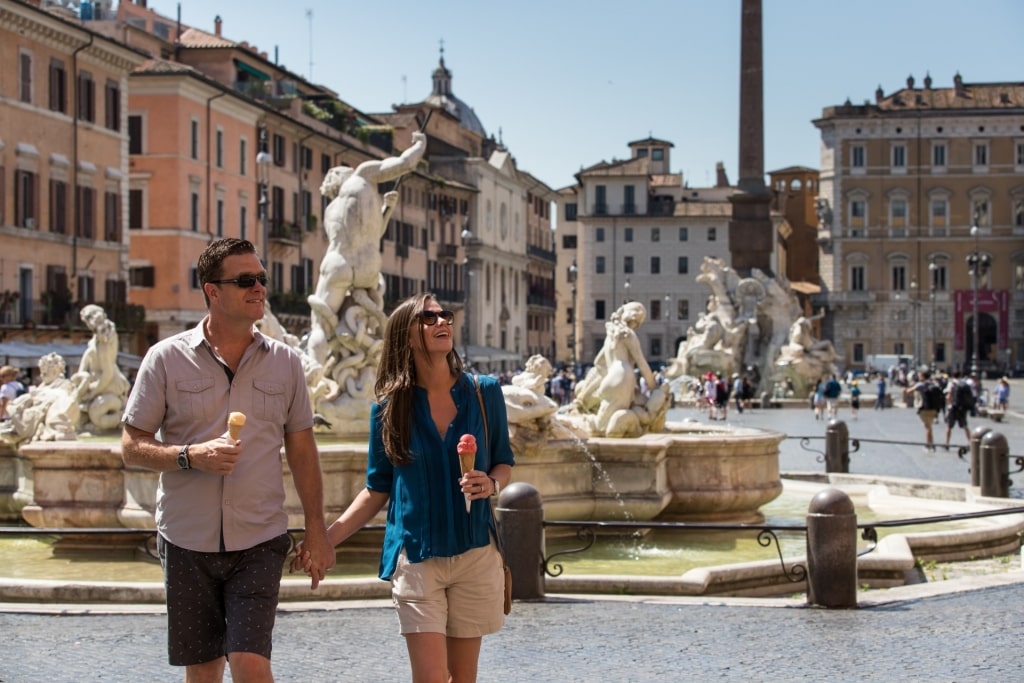
Rome, Lazio
Set off on a journey through Italy’s diverse regions—with every port offering you a different experience—aboard a cruise to Italy with Celebrity Cruises. Experience the romance of Venice, the rustic charms of Cinque Terre, the sunlit glamor of the Amalfi Coast, and so much more.



